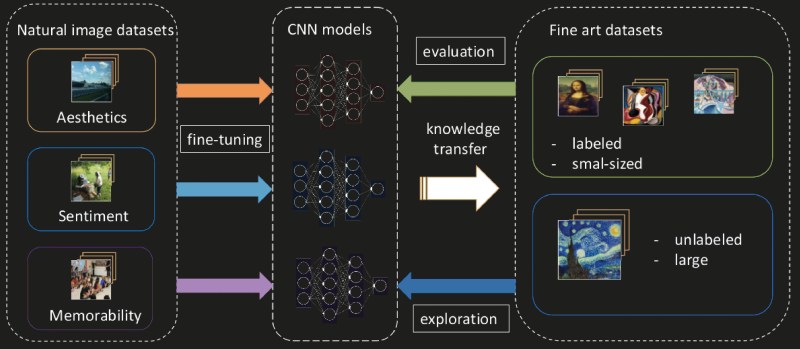In 2019, using AI to evaluate artwork is finally more productive than foolish. We all hope that someday soon our Roomba will judge our living habits and give unsolicited advice on how we could spruce things up with a few pictures and some natural light. There is already an extensive amount of Deep Learning dedicated to photo recognition but a team in Croatia is adapting them for use on fine art. It makes sense that everything is geared toward cameras since most of us have a vast photographic portfolio but fine art takes longer to render. Even so, the collection on Wikiart.org is vast and already a hotbed for computer classification work, so they set to work there.
As they modify existing convolutional neural networks, they check themselves by comparing results with human ratings to keep what works and discard what flops. Fortunately, fine art has a lot of existing studies and commentary, whereas the majority of photographs in the public domain have nothing more than a file name and maybe some EXIF data. The difference here is that photograph-parsing AI can say, “That is a STOP sign,” while the fine art AI can say, “That is a memorable painting of a sign.” Everyone admits that there are still a lot of unknowns when it comes to art and how humans appreciate it, but maybe we are wrong and the repeatable results of computers are correct.
For a quick reference, this study found that aesthetics are highest in photos with content and lighting. Punchy colors and harmony evoke sentimental feelings. The most memorable paintings emphasize the subject. Hopefully, this will help you select your next blog image banner, but we went with a functional image because that is who we are.
Here is some of that photograph recognition software picking on Mark Zuckerberg and a hacker making himself invisible to it.
Via IEEE Spectrum.
















IEEE: smal-sized.
You have a keen eye but to be fair, this was probably translated or written by folks who don’t use English as their first language.
Fascinating! Near as I can figure, all this AI art research is needed because no one has both the bravery and authority to make any statements about which artworks are exemplary, or trash. But if a computer does it, it can be a scientific opinion! Or at least it will be a non-human we can blame.
The bravery you are talking about is just colonialism over the standards of art. This is trained on specific images with human controlled ranking so it inherits the bias of that data and ranking. The bias of the system is to be blamed on the people who picked the training set not the computer that executes the commands.
Trying to simplify centuries of history and philosophy into a absolute rating is a horrible idea.
Jokes on you roomba i have not taste or pictures on my wall! hahaha
After they can quantify what qualifies as art, AI manufactured “Art” will be next. It is a matter of mixing the “ingredients” at the right ratios that consumers like.
https://futurism.com/the-worlds-first-album-composed-and-produced-by-an-ai-has-been-unveiled
>Amper is an artificially intelligent music composer, producer, and performer. The AI was developed by a team of professional musicians and technology experts, and it’s the the very first AI to compose and produced an entire music album. The album is called I AM AI, and the featured single is set to release on August 21, 2017.
Hot damn, I didn’t know about Wiki Art. That is incredibly handy!
Typically I just use Google Images to get a bunch of random crap for sources.
As for art, it’s very very subjective in terms of what evokes a response.
However, there is an objective side to it too, a reliable method to creating something that is at least considered of High Quality, such as good composition, texture, color contrast, consistency, image “flow” (where your eyes are lead around an image, taking advantage of that properly can make the difference between decent and brilliant)
Of course, there’s 2 sides to those qualities, whether one wants them in the picture or not.
This can create incredibly simple but attractive art pieces, or incredibly complex, just by varying those values.
An autoencoder can already vary some of these, as Google (?? I think.) demonstrated with its artificial “weathering” ML system that could modify pictures to different climates.
Only a matter of time before it can take on the more complex tasks like flow, texture, composition, then we’ll be getting masterpieces from doArt.exe
OK, but the real question is can it finally settle the debate on weather “Dogs playing Poker” is fine art or not. (And if it says “No” it’s not working.)
Art appreciation is entirely subjective, different people like different things, even about the same work of art. An artist tries to provoke an emotional response. Not everyone gets the intent of the artist’s work. There are some people who simply get emotional over the price tag, and clueless as to why it’s so expensive. There is no way a computer can learn emotions or subjective thinking, doesn’t follow any logic. If a computer has to do your decorating for you, you probably would care what it picks.
There’s a long debate in art about whether aesthetics or meaning are what matter. Here, the AI can only see what it sees, with no understanding of meaning. It’s like the perfect experiment.